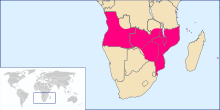- Pink Map
-
The Pink Map (Portuguese: Mapa cor-de-rosa) was a document representing Portugal's claim of sovereignty over the land between Angola and Mozambique, which today is currently Zambia, Zimbabwe and Malawi. The Pink Map collided with Sir Cecil Rhodes' "Cape to Cairo Red Line". The dispute with the United Kingdom over these territories led to the 1890 British Ultimatum, to which Portugal gave in, causing serious damage to the image of the Portuguese monarchy, and the subsequent rise of the Republican political movement.
At the height of European colonialism in the 19th century, Portugal had lost its territory in South America and all but a few bases in Asia. During this phase, Portuguese colonialism focused on expanding its outposts in Africa into nation-sized territories to compete with other European powers there. Portuguese territories eventually included the modern nations of Cape Verde, São Tomé and Príncipe, Guinea-Bissau, Angola, and Mozambique.
Portugal pressed into the hinterland of Angola and Mozambique, and in 1877 explorers Serpa Pinto, Hermenegildo Capelo and Roberto Ivens were among the first Europeans to cross Africa west to east. The project to connect the two colonies, the Pink Map, was the Portuguese main objective in the second half of the 19th century. However, the idea was unacceptable to the British, who had their own aspirations of contiguous British territory running from Cairo to Cape Town. The British Ultimatum of 1890 was respected by King Carlos I of Portugal and the Pink Map came to an end. The King's reaction to the ultimatum was exploited by republicans. In 1908 King Carlos and Prince Luís Filipe were murdered in Lisbon. Luís Filipe's brother, Manuel, become King Manuel II of Portugal. Two years later Portugal became a republic.
References
Charles L. Nowell, The rose-colored map: Portugal's attempt to build an African empire from the Atlantic to the Indian Ocean. (Lisbon: Junta de Investigações Científicas do Ultramar, 1982)
Categories:- Colonialism
- British colonisation in Africa
- Portuguese colonisation in Africa
- History of Portugal
- History of Africa
- History of Angola
- History of Mozambique
- Geopolitical rivalry
- Angola stubs
- Malawi stubs
- Mozambique stubs
- Portugal stubs
- Zambia stubs
- Zimbabwe stubs
Wikimedia Foundation. 2010.

